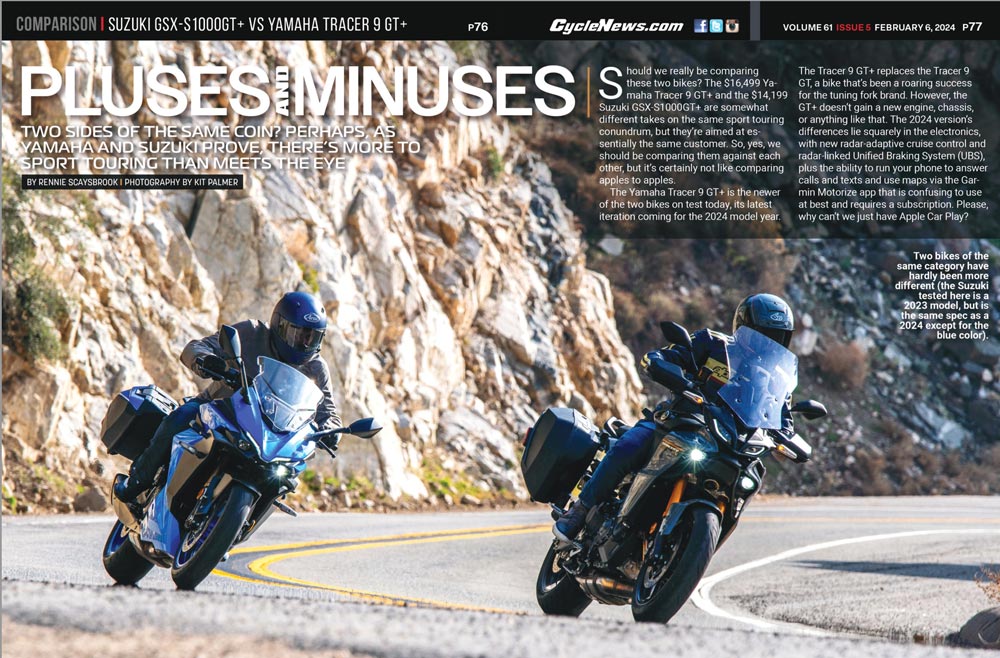Rennie Scaysbrook | February 12, 2024
Two sides of the same coin? Perhaps, as Yamaha and Suzuki prove, there’s more to sport touring than meets the eye.
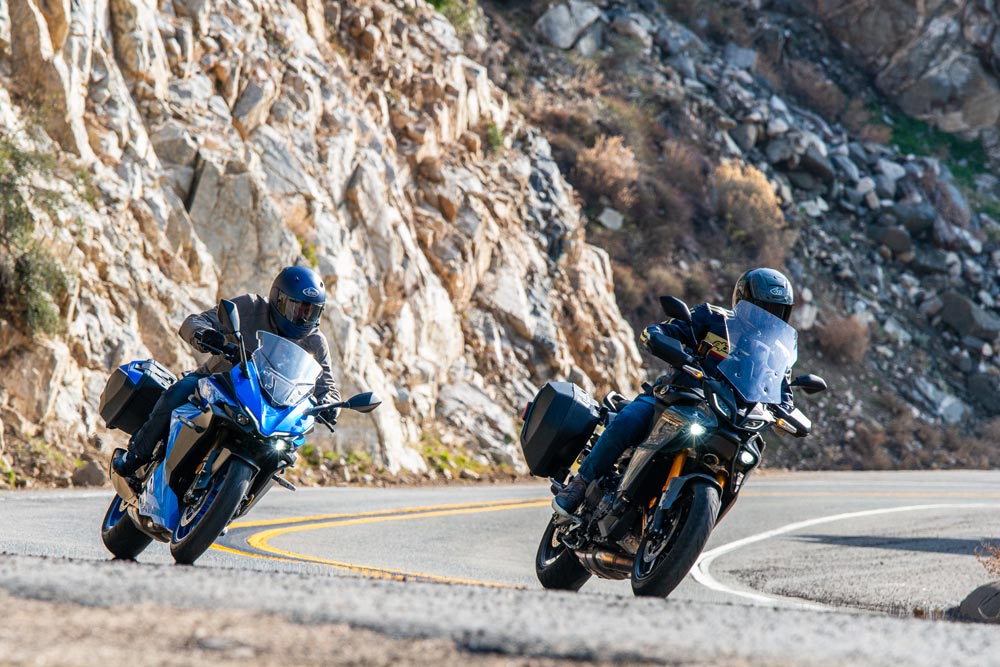 Two bikes of the same category have hardly been more different (the Suzuki tested here is a 2023 model, but is the same spec as a 2024 except for the blue color).
Two bikes of the same category have hardly been more different (the Suzuki tested here is a 2023 model, but is the same spec as a 2024 except for the blue color).
Photography by Kit Palmer
Should we really be comparing these two bikes? The $16,499 Yamaha Tracer 9 GT+ and the $14,199 Suzuki GSX-S1000GT+ are somewhat different takes on the same sport touring conundrum, but they’re aimed at essentially the same customer. So, yes, we should be comparing them against each other, but it’s certainly not like comparing apples to apples.
The Yamaha Tracer 9 GT+ is the newer of the two bikes on test today, its latest iteration coming for the 2024 model year. The Tracer 9 GT+ replaces the Tracer 9 GT, a bike that’s been a roaring success for the tuning fork brand. However, the GT+ doesn’t gain a new engine, chassis, or anything like that. The 2024 version’s differences lie squarely in the electronics, with new radar-adaptive cruise control and radar-linked Unified Braking System (UBS), plus the ability to run your phone to answer calls and texts and use maps via the Garmin Motorize app that is confusing to use at best and requires a subscription. Please, why can’t we just have Apple Car Play?
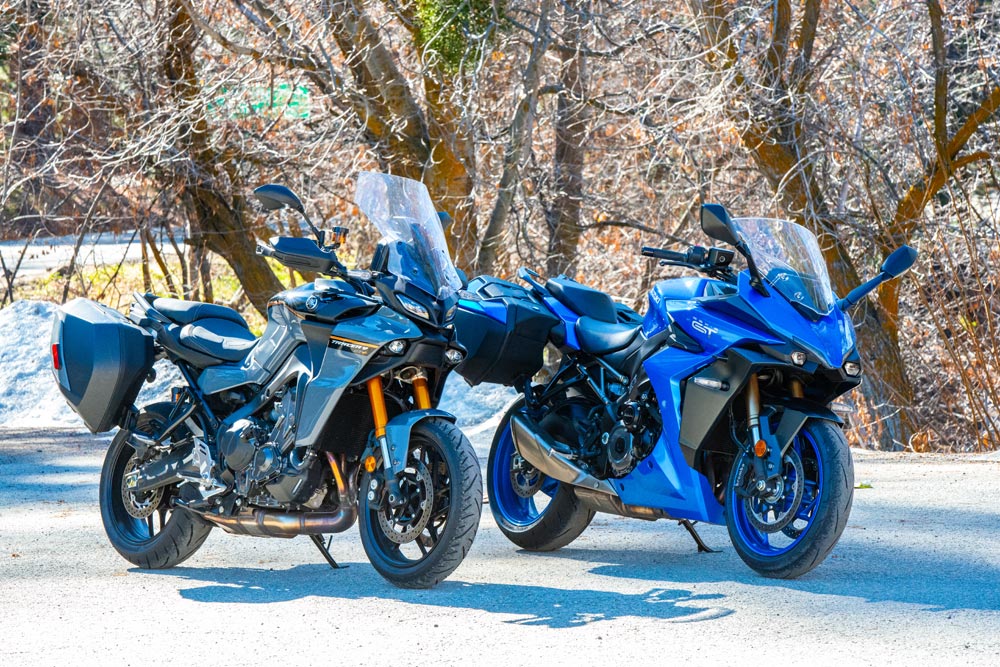 One is a sportbike with panniers, the other is a supermoto with a high screen.
One is a sportbike with panniers, the other is a supermoto with a high screen.
The Yamaha is by far the most tech-laden of this test. It has a revised six-axis Inertial Measurement Unit with the latest-generation KYB Actimatic Damper System (KADS) electronically-controlled suspension running two modes—the stiffer A-1 for sporty riding and A-2 for a softer ride—and the KADS system will make changes to the damping rates on the fly as you lean the bike into corners.
On top of this, you’ve got four modes of Rain, Street, Sport, and Custom that are essentially mission control for Yamaha’s behaviors. Each mode comes with its own preset levels of traction control, slide control, wheelie control, engine power, and either A1 or A2, but the Custom mode allows you to go in and program any level you want of these systems.
Yamaha’s got the modes pretty spot on. The only reason you’d want to get into the Custom mode is if you wanted to put the wheelie control on its lowest setting so you can have a bit of one-wheeled fun.
It’s only when you compare the Yamaha to the Suzuki that you realize how little tech the Suzuki has or, should I say, has not. The GSX-S doesn’t run an IMU, so it doesn’t get lean-angle-sensitive traction control, cornering ABS, or even wheelie control.
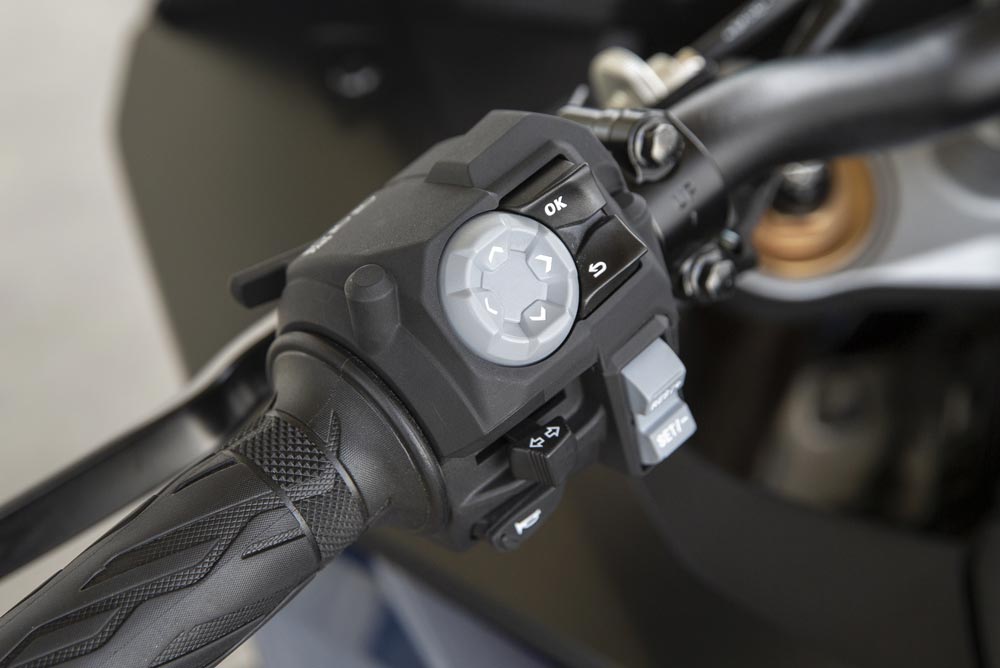 Mission control for the Suzuki is basic at best, which isn’t a bad thing.
Mission control for the Suzuki is basic at best, which isn’t a bad thing.
You get basic cruise control—no radar means no adaptive cruise—and you get Suzuki’s first (that’s right, first) color TFT dash that you can Bluetooth your phone to. You can change the three engine modes, five stages plus Off traction control, and switch the quickshifter on and off. God knows why you’d want to turn it off, as it’s one of the best quickshifters on the market today. The suspension is old-school KYB, no electronic suspension here, which is reflected in the $2300 price difference.
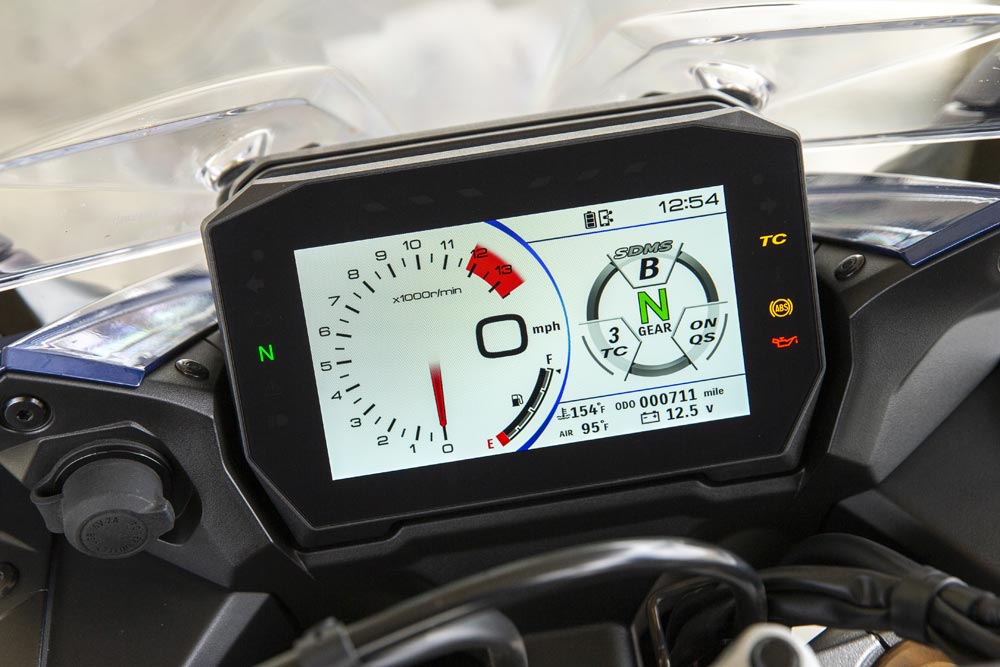 Suzuki’s first TFT dash is a good example of giving the rider everything they need and nothing they don’t.
Suzuki’s first TFT dash is a good example of giving the rider everything they need and nothing they don’t.
As for the hardware, there are marked differences between these motorcycles. The Yamaha runs that stupendous CP3 890cc inline-triple motor that Yamaha claims produces 108 horsepower and 63 lb-ft of torque, while Suzuki has its very tried and tested K5-derived 999cc inline four-cylinder that produces a claimed 149 horsepower and 78 lb-ft of torque, so first strike definitely goes to the Suzuki on this one.
The Yamaha delivers its torque in a much punchier fashion compared to the Suzuki. Around town, the Yamaha is a more sensible proposal. The low-down torque from the three-cylinder motor means you can afford to be a little lazy with your shifts and just wind the throttle on, greeted by strong drive until about 6000 rpm. It’s at this point the Yamaha labors through a flat spot until drive is restored in full flight at around 7800 rpm, and then you’re off to the races.
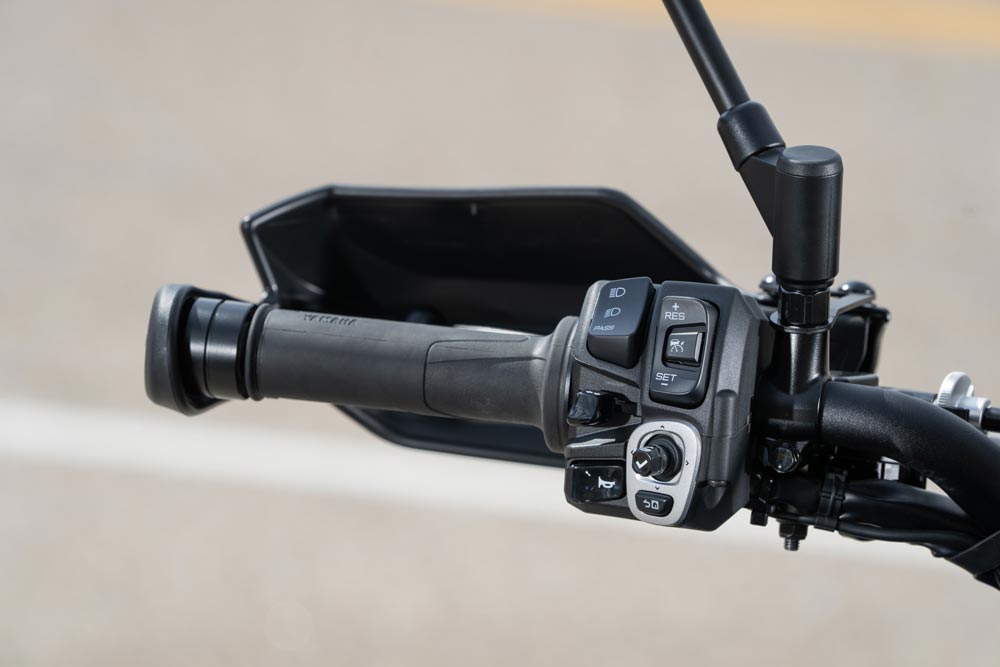 Adjusting the Yamaha’s myriad of electronics is done via the little joystick on the left handlebar. Some love it, others not so much.
Adjusting the Yamaha’s myriad of electronics is done via the little joystick on the left handlebar. Some love it, others not so much.
By contrast, the Suzuki’s significant power and torque advantage gives a calmer engine character, just without the early rpm torque the Yamaha enjoys. The K5 motor builds its power steadily and doesn’t suffer the flat spot issue present on the Yamaha, and although the Yamaha has a revised quickshifter, it’s still not as smooth as that on the Suzuki, which is knife-through-butter stuff.
Speaking of electronics, Suzuki’s lack of them is actually a nice surprise. We live in a time when more is almost always better, but perhaps we’re seeing a bit of a turning point where instead of having almost everything be electronically adjustable, the Suzuki seems to have whittled down the range of choice to things that truly matter for a sport touring bike.
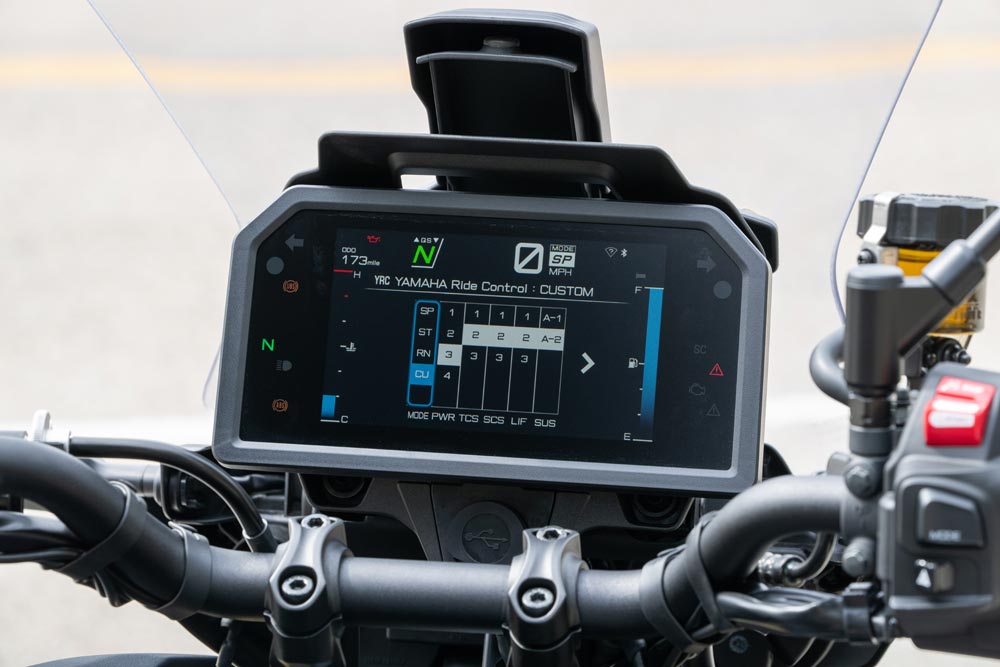 Yamaha ditched the split screen dash layout for 2024, and the result is a much easier-to-read and conventional design.
Yamaha ditched the split screen dash layout for 2024, and the result is a much easier-to-read and conventional design.
Yamaha has done an exceptional job making their electronics as easy to use as possible via the left-side joystick, and anyone who’s tried radar-adaptive cruise control will attest to how good it really is. But it’s up to you if you really need it. If you’re doing big miles where there are lots of freeways, there is no question that having radar-adaptive cruise control is a game changer. But if you’re more akin to backroad twisties with minimal straight roads, perhaps you won’t need it.
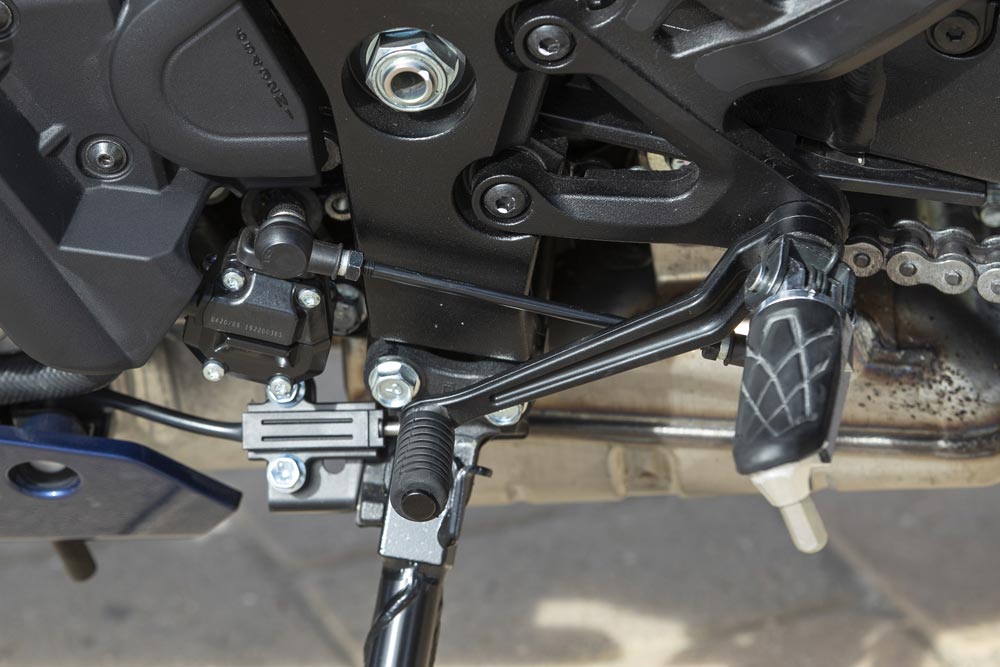 Suzuki’s basic quickshifter is a smoother operator than Yamaha’s new-for-2024 unit.
Suzuki’s basic quickshifter is a smoother operator than Yamaha’s new-for-2024 unit.
Suzuki runs the SDMS (Suzuki Drive Mode Select), which retains A, B and C modes for full, medium, or soft throttle response. The Yamaha, by contrast, has four modes of Rain, Street, Sport and Custom, and I found over the test I would spend most of the time in Street mode.
As mentioned, the Yamaha’s modes change everything within the machine—throttle response, suspension setup, traction, slide and wheelie control—whereas the Suzuki’s SDMS only influences the throttle response. However, the Suzuki’s KYB fork and shock are set up nicely from the factory so the fact I couldn’t change the suspension modes on the fly meant very little to me.
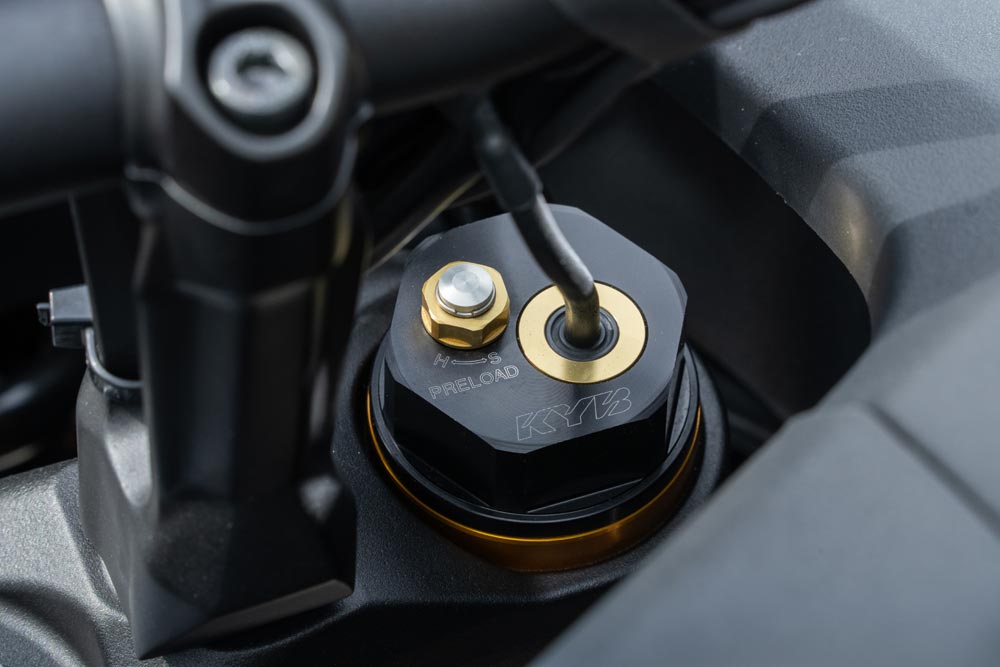 An ace in the Yamaha’s adjustability is the electronic suspension compared to the conventionally adjustable units of the Suzuki.
An ace in the Yamaha’s adjustability is the electronic suspension compared to the conventionally adjustable units of the Suzuki.
Regarding the chassis performance, this is where the two bikes really stand apart. They are diametrically opposed, as one is effectively a sport bike and the other a supermoto with a big screen.
The Yamaha’s ergonomics help the rider carve through corners with exceptional ease. The steering is sharper and faster on the Yamaha over the Suzuki, which has a slower rate of turn but conversely is more stable over fast, long sweeping turns than the Yamaha, which can seem almost nervous when speeds increase.
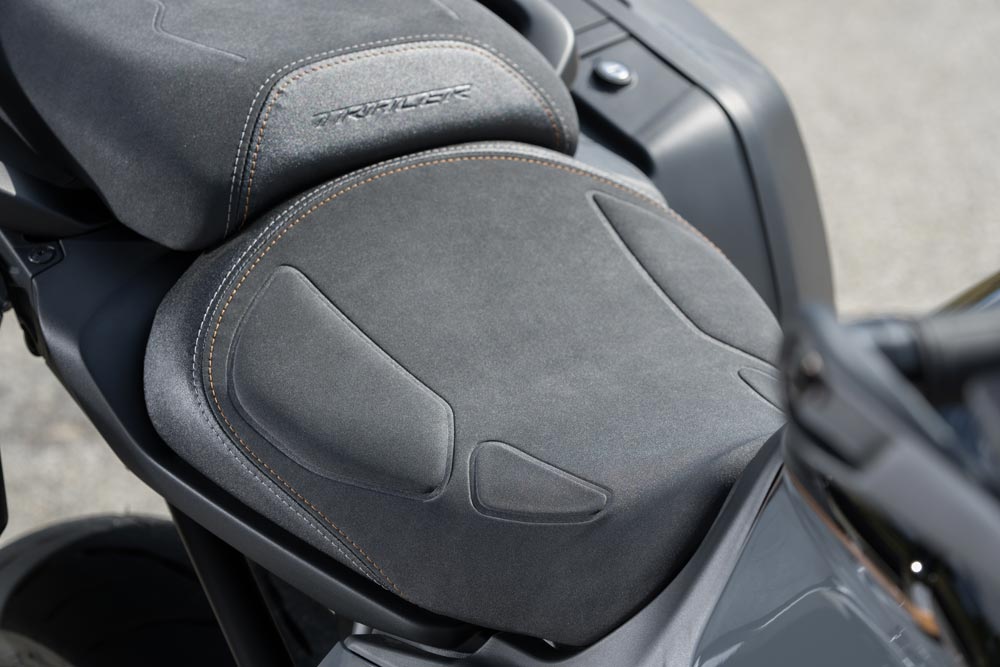 Yamaha has revamped the seat for 2024, and it provides excellent all-day comfort.
Yamaha has revamped the seat for 2024, and it provides excellent all-day comfort.
The Yamaha has the rider sitting much more upright than the Suzuki, putting them in a near dirt bike ride position. A straight back and absolutely no weight on the wrists means you can ride for hour after hour on the Yamaha, although they have suffered their own goal by fitting a screen that does nothing except deflect the oncoming air, instead sending it into the bottom or top of the rider’s helmet and buffeting them to death, depending on the setting you have chosen. There are 10 stages of adjustment with the Yamaha’s screen, but, as CN editor Kit Palmer said in his launch report, it’s really only two stages—up or down. Personally, I’d just take the screen off or put a tiny little wind deflector piece on there.
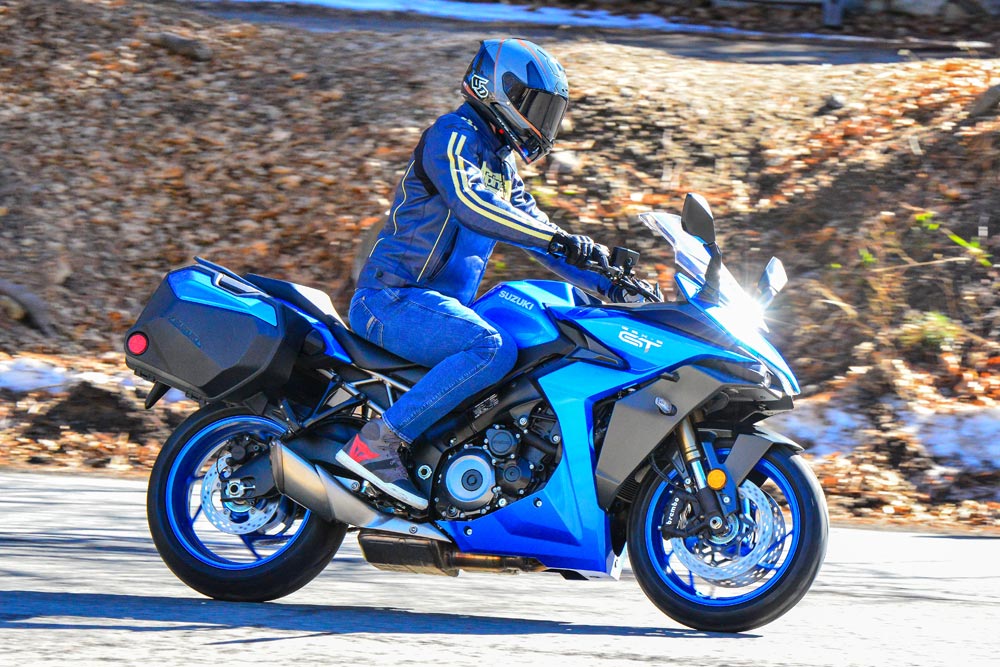 The rider leans a touch forward from center on the Suzuki, which takes some of the weight off the rider’s tailbone.
The rider leans a touch forward from center on the Suzuki, which takes some of the weight off the rider’s tailbone.
Moving onto the Suzuki, a lower seat height and slightly forward from vertical riding position takes a bit of weight off the rider’s tailbone and I conversely found it more comfortable than the Yamaha after a day on board.
The ride position puts you in a more natural sports attack stance, which allows you to put a bit more weight on the front tire and help the Suzuki initiate the turn. The conventionally adjustable KYB suspension is far from a detraction when you start to wind the wick up, and the chassis’ greater stability in medium- to higher-speed twisties is a nice factor over the Yamaha.
The Yamaha has a much nicer feel under brakes from the front master cylinder compared to the Suzuki’s, which has a wooden feel that is, unfortunately, becoming a bit of a trait with Suzukis these days. A new master cylinder would fix this instantly, but I feel it shouldn’t be something the customer should have to do; it should be done for them.
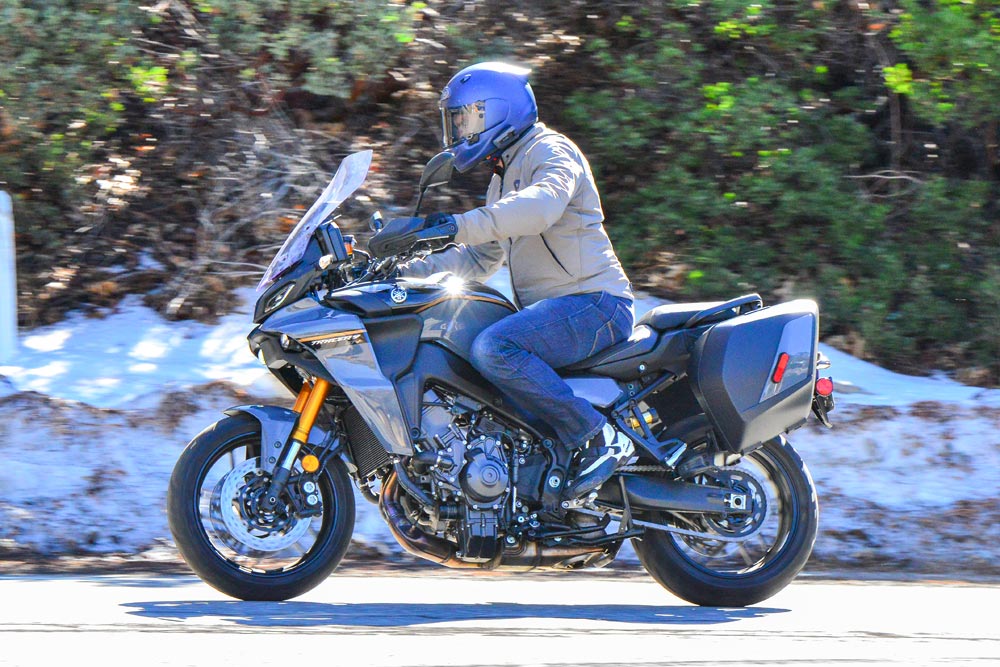 Higher-set handlebars put the Yamaha rider in a near-perfect neutral riding position.
Higher-set handlebars put the Yamaha rider in a near-perfect neutral riding position.
The same is also true of the lack of heated grips on the Suzuki. Yes, you can have them as accessories, but this is a sport-touring bike, and they should come as standard fitment, just like on the Yamaha.
It wouldn’t be a sport touring test without talking about luggage capacity, and again, it’s two answers to the same problem. The Yamaha runs two 30-liter side cases, whereas the Suzuki runs two 27.5-liter cases. However, the Yamaha’s cases are taller and slimmer, which ensures not all full-face helmets fit—if you’re running a lid like an Arai Corsair-X or Shoei X-Fifteen that has spoilers on them, you’re out of luck.
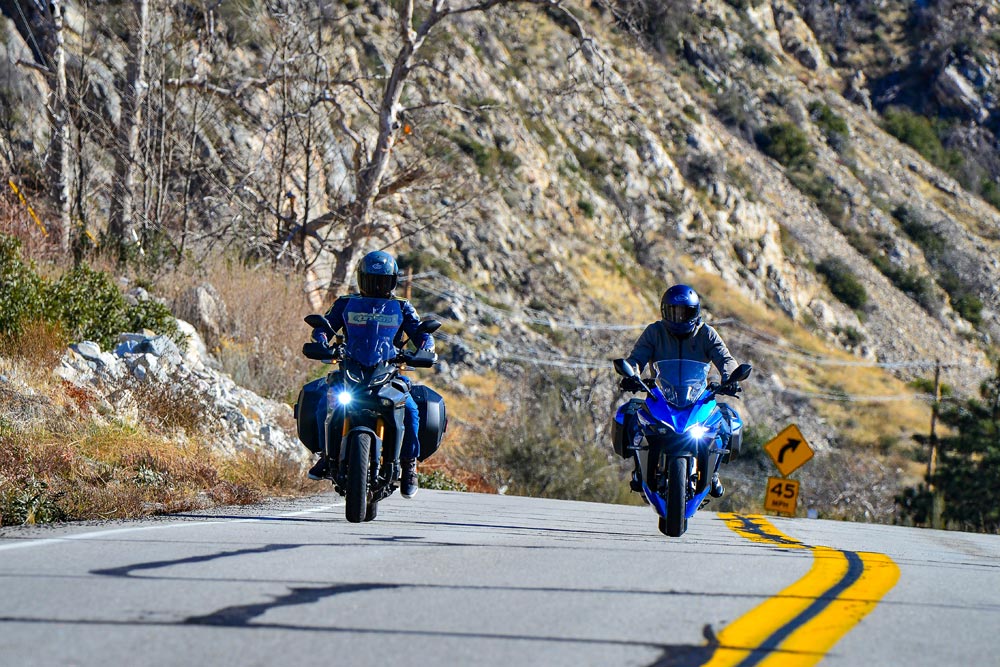 The Yamaha’s much taller screen (left) angles the wind right into the rider’s helmet, which can get very annoying after a while.
The Yamaha’s much taller screen (left) angles the wind right into the rider’s helmet, which can get very annoying after a while.
The Suzuki runs a more traditional (wider) shaped case that will accommodate a broader range of helmets, but they’re not as svelte and look a little bulgy. But I guess that won’t be a concern when you can fit your helmet in the Suzuki’s cases and not in the Yamaha’s.
Perhaps by now you’d be thinking the Suzuki is going to win the test, and you’d be right, but it’s not that clear cut. The Suzuki is a more polished article for the stuff I want—nicely set up, conventional suspension, a ride position that takes weight off my tailbone without outing it on my wrists, and an engine that’s a sheer joy to ride and listen to.
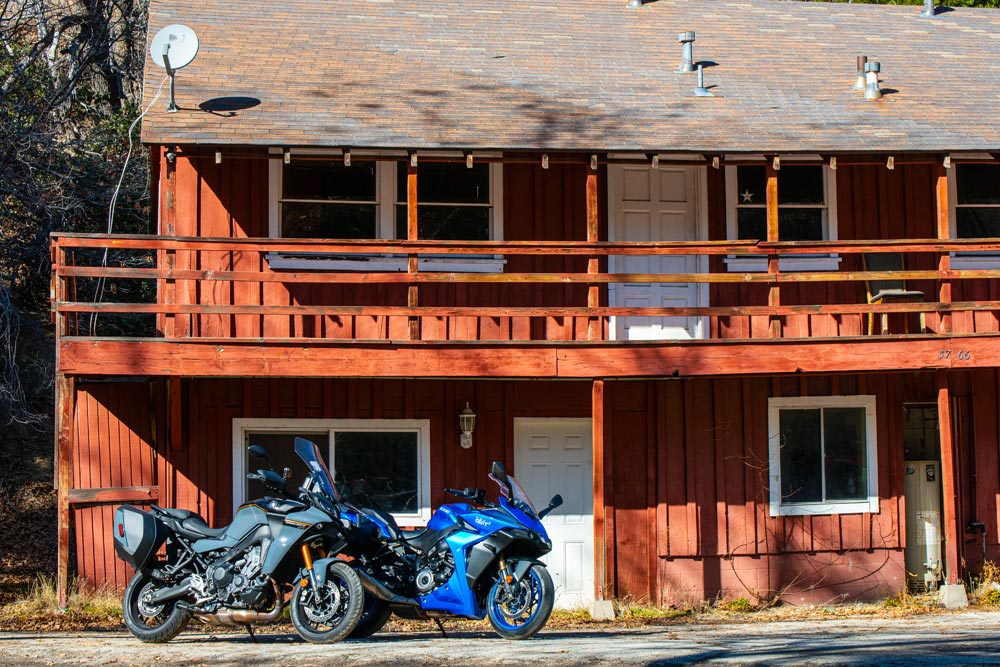 You’ll not go wrong with either bike; you just need to be honest with the kind of ride experience you’re after.
You’ll not go wrong with either bike; you just need to be honest with the kind of ride experience you’re after.
The Yamaha, on the other hand, is a brilliantly executed bike and has so much more than the Suzuki in terms of electronics, especially the radar-adaptive cruise control. The interesting thing to note is the Suzuki will most likely have to fit an IMU in the next few years and thus radar-adaptive cruise control, electronic suspension, cornering ABS, etc., will all become a reality. As will a steep increase in price. It’s inevitable.
Whether that increase in adjustability/electronics then neuters the advantage the Suzuki has in terms of ease of use remains to be seen, but for now, my vote—and I’m as surprised as anyone—is going to the Suzuki. CN
VIDEO | Yamaha Tracer 9 GT+ vs Suzuki GSX-S1000GT+ Comparison
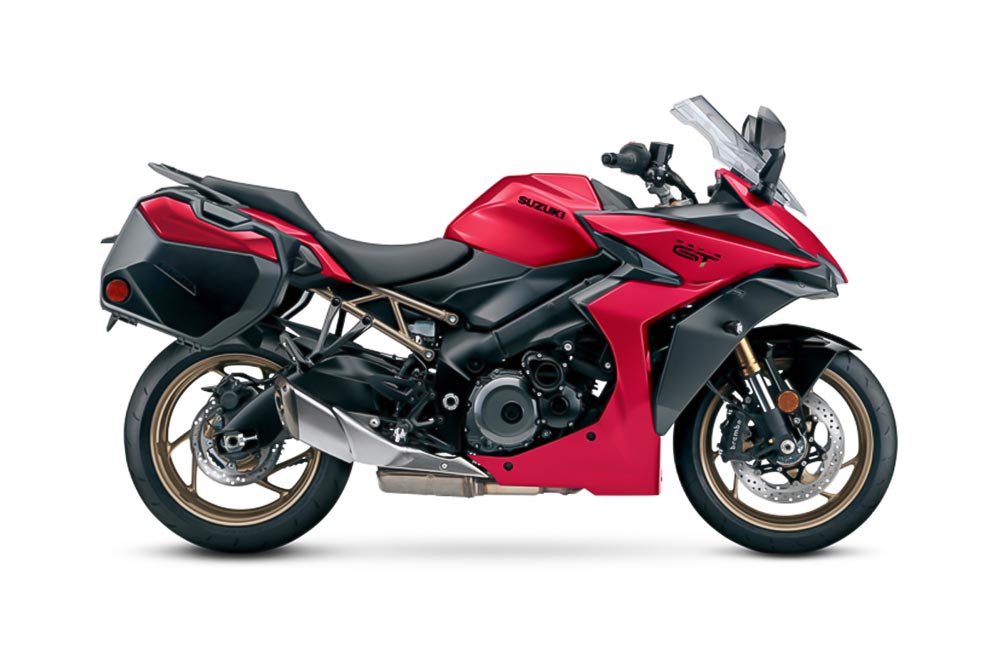
2024 Suzuki GSX-S1000 GT+ Specifications
| MSRP: |
$14,199 |
| Engine: |
Four-stroke, four-cylinder, |
| Valvetrain: |
DOHC, 16-valve |
| Cooling system: |
Liquid |
| Power: |
149 hp at 11,000 rpm |
| Torque: |
78 lb-ft at 9250 rpm |
| Displacement: |
999cc |
| Bore x stroke: |
73.4 x 59mm |
| Compression ratio: |
12.2:1 |
| Fuel system: |
EFI, 4 x 40mm throttle bodies |
| Exhaust: |
4/2/2001 |
| Transmission: |
6-speed |
| Chassis: |
Aluminum twin-spar |
| Front suspension: |
KYB fork, fully adjustable |
| Rear suspension: |
KYB shock, adjustable rebound damping and preload |
| Front brake: |
Brembo Monobloc 4-piston, radially mounted caliper, 310mm disc, ABS |
| Rear brake: |
Nissin 2-piston, fixed caliper, 240mm disc, ABS |
| Front tire: |
120/70 ZR17 in. |
| Rear tire: |
190/50 ZR17 in. |
| Wheelbase: |
57.5 in |
| Seat height: |
31.9 in. |
| Fuel capacity: |
5.0 gal. |
| Weight (curb, claimed): |
498 lbs. |
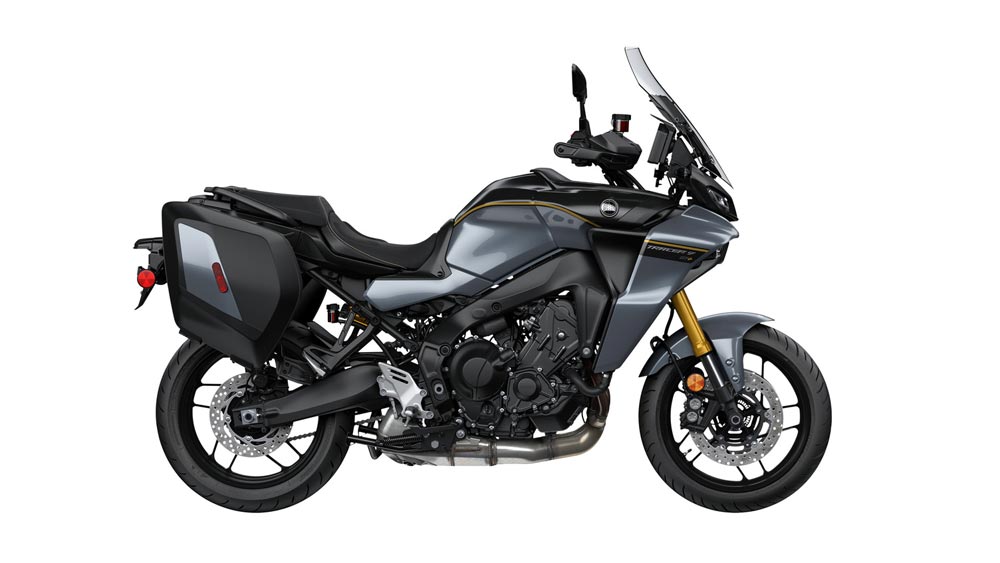
2024 Yamaha Tracer 9 GT+ Specifications
| MSRP: |
$16,999 |
| Engine: |
Four-stroke, three-cylinder |
| Valvetrain: |
DOHC, 12-valve |
| Cooling system: |
Liquid |
| Power: |
108 hp at 10,000 rpm |
| Torque: |
63 lb-ft at 7200 rpm |
| Displacement: |
999cc |
| Bore x stroke: |
78 x 62.1mm |
| Compression ratio: |
11.5:1 |
| Fuel system: |
EFI, YCC-T, three 41mm throttle bodies |
| Exhaust: |
3-2-1 |
| Transmission: |
6-speed |
| Chassis: |
Cast aluminum |
| Front suspension: |
41 KYB electronically adjustable fork, rebound & compression, manually adj. preload |
| Rear suspension: |
Single shock, electronically adj. rebound, manually adj. preload (remote) |
| Front brake: |
Monobloc 4-piston, radially mounted caliper, 298mm disc, ABS |
| Rear brake: |
Nissin 2-piston, fixed caliper, 267mm disc, ABS |
| Front tire: |
120/70 ZR17 in. |
| Rear tire: |
180/55 ZR17 in. |
| Wheelbase: |
59.1 in. |
| Seat height: |
32.3/32.9 in. |
| Fuel capacity: |
5.0 gal. |
| Weight (curb, claimed): |
492 lbs. |
